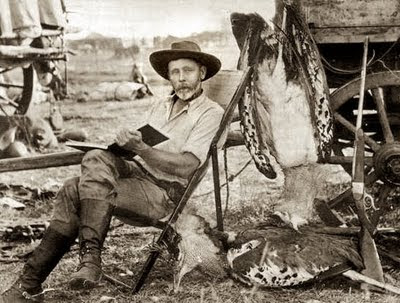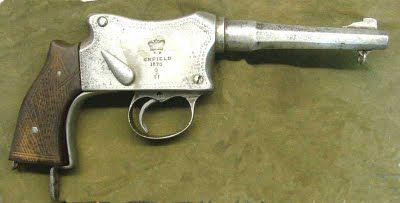 Frederick Selous (left) with his Marklin Rifle (right).
Frederick Selous (left) with his Marklin Rifle (right).The Marklin (or the Märklin, as my keyboard stubbornly refuses to spell out for me) was made famous by the Norwegian crime fiction writer
Jo Nesbo in his book
The Redbreast. In the novel Nesbo featured this weapon not as a hunter's rifle, but as the weapon of an assassin. Since then it's come into some prominence among his fans and among some amateur gun enthusiasts and people who just generally wonder, what the heck is this wonder rifle?
A brief search on the internet shows that therer is a lot of hearsay and what-have-you regarding the rifle and whether or not it actually exists. Unfortunately, the internet has far more bad information about the rifle and it's unusual history than it does accurate information.
This whole business reminds me of something I read about when I was reading up on the William Shakespeare and the
conspiracy theory that he did not actually write his own plays (which, you'll trust me on this one, is an actual belief that some people adhere to, which, to me, just goes to show that sometimes all it takes to fool a smart person is another smart person). One of the counter-arguments to this theory is truly one of the most elegant things I have ever read. The counter-argument claims that that the absence of evidence does not necessarily mean the evidence of absence. Just because you can't find something doesn't mean it didn't happen, and just because you can't prove something that does not mean that it is suddenly and irrecoverably dispelled.
Or that's the reading I take from that whole business.
Much of the problem with the rifle has to do with the fact that it shares its name with a toy manufacturer. A lot of googling and yahooing and binging (haha, let's not kid ourselves) turns up nothing but toy cannons and trains or whatever else, which murks the water. At that point I know a lot of people give up, I know I almost did, but I can assure you, the Marklin Rifle is a very real weapon. There's more than a few elephants and men hanging out in the afterlife who will tell you the same (I mean, you know, if you speak elephant).
The Marklin was in fact designed around the turn of the century by a cannon manufacturer looking to branch out in sport shooting. Using the same
falling block action design as the famous British
Martini-Henry Rifle (with a significant scaling, naturally), the was very much a rifle in keeping with the late 19th century-- at least in terms of upscale hunting rifles. While it was hardly groundbreaking, it was a fairly unique weapon.
The problem with the Marklin wasn't that it was a just boutique weapon (which it was) or that it had a unique caliber (which being a 16mm makes it bizarre even among elephant guns) or that it was a falling block weapon in the age where bolt-action rifles were becoming popular-- it was
all of these things. The Marklin Rifle hit the market too little and too late. The little cannon maker that could soon folded up its small arms division after only selling a small number of the weapons in the last decades of the 19th century.
In no time at all, the rifle was overshadowed by cheaper weapons with less fussy maintainance routines and less expensive ammunition. Why spend that many krones or marks or pounds or whatever when you could buy maybe two high-end rifles for the same price? Maybe if the rifle found a base of customers it could have driven down the price and really made something of it, but that only exists where some sort of jonbar hinge dropped in and made this finicky rifle something more than it was. That world doesn't exist, obviously and all we're left with is a story-- unless you're an antique arms collector.
If you ask Jo Nesbo, the real market with the Marklin rifle is exclusively
Neo-Nazi psychopaths (a redundancy if there ever was one), so maybe it's for the best this rifle never took off.
Nesbo also mentions that the Marklin used a special type of bullet (beyond using a 16,, shell). Nesbo's assertion that it uses "Singapore bullets" is true, with some minor liberties. The Marklin's 16mm bullets used "
Dum Dum" rounds, which is a kind of a ball designed to expand upon impact and create larger, uglier, and rougher wounds. Dum Dum bullets are so named from a
factory in the Indian town of
Dum Dum that produced soft-leaded bullets that were the predecessors to our modern hollow point bullets. This is one of the main reasons the Marklin is thought of as such a bizarre weapon. While one can chamber any firearm with soft-lead very few are designed to chamber that sort of shell exclusively.
This is one of the main reasons the Marklin was destined to become nothing more than a curio-- a stillborn one at that. The
1868 Declaration of St. Petersburg put an international ban on expanding bullets over a certain weight and the
1899 Hague Convention, reinforced the taboo on the sort of bullet that the Marklin was built for. In effect, these two treatises banned the 16mm bullets the Marklin required for use against God's largest and ugliest animals (man rarely being one and often the other).
Considering this, it isn't likely the Marklin ever saw much action in battle. The prohibitive price, strange ammunition, and general illegality likely kept it out of all but the most desperate hands. Besides, even back during the Second Boer War where it might have seen combat, it would be worth more as a collectible than as an instrument of war.
With all that said, anyone who thinks that the Marklin isn't real, I'd suggest they do an actual cursory search and then write about what they find instead of just giving up when they don't hit pay dirt. Unfortunately there's a lot of that sort of thing going on in the world. People read the first thing they see and they just believe it at its word. Oh well, at least it gives me a chance to talk about guns and crime books and in the end, isn't that what it's all about?
Sources:
Anthony North, Ian V. Hog, (2004). Book of Guns and Gunsmiths, 2004. Quantum Books. p. 256
Arthur Augustus Thurlow Cunynghame, M. Balkind, (1880). My Command in South Africa, 1874-1878. Macmillan & Co.. p. 79.
Kirton, Jonathan: The British Falling Block Breechloading Rifle From 1865 (1997), p. 97




